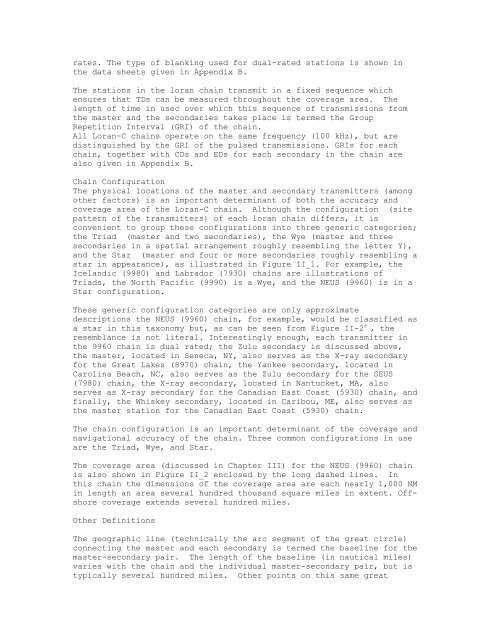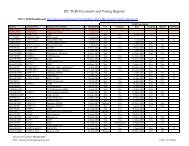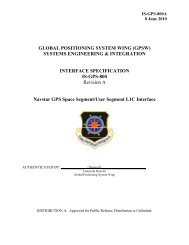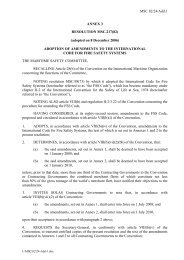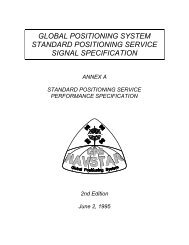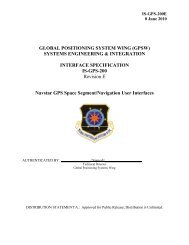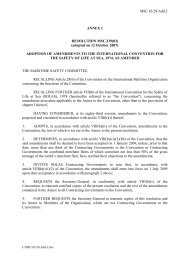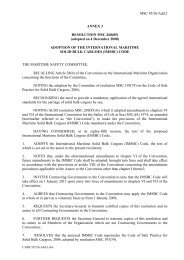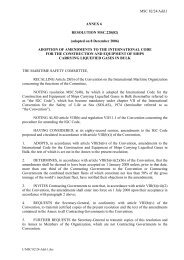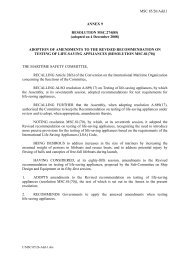The LORAN-C System - US Coast Guard Navigation Center
The LORAN-C System - US Coast Guard Navigation Center
The LORAN-C System - US Coast Guard Navigation Center
Create successful ePaper yourself
Turn your PDF publications into a flip-book with our unique Google optimized e-Paper software.
ates. <strong>The</strong> type of blanking used for dual-rated stations is shown inthe data sheets given in Appendix B.<strong>The</strong> stations in the loran chain transmit in a fixed sequence whichensures that TDs can be measured throughout the coverage area. <strong>The</strong>length of time in usec over which this sequence of transmissions fromthe master and the secondaries takes place is termed the GroupRepetition Interval (GRI) of the chain.All Loran-C chains operate on the same frequency (100 kHz), but aredistinguished by the GRI of the pulsed transmissions. GRIs for eachchain, together with CDs and EDs for each secondary in the chain arealso given in Appendix B.Chain Configuration<strong>The</strong> physical locations of the master and secondary transmitters (amongother factors) is an important determinant of both the accuracy andcoverage area of the Loran-C chain. Although the configuration (sitepattern of the transmitters) of each loran chain differs, it isconvenient to group these configurations into three generic categories;the Triad (master and two secondaries), the Wye (master and threesecondaries in a spatial arrangement roughly resembling the letter Y),and the Star (master and four or more secondaries roughly resembling astar in appearance), as illustrated in Figure II_1. For example, theIcelandic (9980) and Labrador (7930) chains are illustrations ofTriads, the North Pacific (9990) is a Wye, and the NE<strong>US</strong> (9960) is in aStar configuration.<strong>The</strong>se generic configuration categories are only approximatedescriptions the NE<strong>US</strong> (9960) chain, for example, would be classified asa star in this taxonomy but, as can be seen from Figure II-2 6 , theresemblance is not literal. Interestingly enough, each transmitter inthe 9960 chain is dual rated; the Zulu secondary is discussed above,the master, located in Seneca, NY, also serves as the X-ray secondaryfor the Great Lakes (8970) chain, the Yankee secondary, located inCarolina Beach, NC, also serves as the Zulu secondary for the SE<strong>US</strong>(7980) chain, the X-ray secondary, located in Nantucket, MA, alsoserves as X-ray secondary for the Canadian East <strong>Coast</strong> (5930) chain, andfinally, the Whiskey secondary, located in Caribou, ME, also serves asthe master station for the Canadian East <strong>Coast</strong> (5930) chain.<strong>The</strong> chain configuration is an important determinant of the coverage andnavigational accuracy of the chain. Three common configurations in useare the Triad, Wye, and Star.<strong>The</strong> coverage area (discussed in Chapter III) for the NE<strong>US</strong> (9960) chainis also shown in Figure II_2 enclosed by the long dashed lines. Inthis chain the dimensions of the coverage area are each nearly 1,000 NMin length an area several hundred thousand square miles in extent. Offshorecoverage extends several hundred miles.Other Definitions<strong>The</strong> geographic line (technically the arc segment of the great circle)connecting the master and each secondary is termed the baseline for themaster-secondary pair. <strong>The</strong> length of the baseline (in nautical miles)varies with the chain and the individual master-secondary pair, but istypically several hundred miles. Other points on this same great


